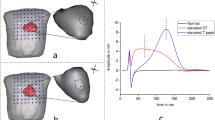Abstract
We have developed an iso-integral mapping technique that uses magneto-cardiogram (MCG) data to obtain a map as projected total current image on the torso from the heart. We have also investigated the applicability of iso-integral mapping to the diagnosis of ischemic heart disease. We simulated and measured the characteristics of two types of iso-integral maps: one using tangential (B xy ) components, and one using the normal component (B z ). Each vector component was measured by two types of superconducting quantum interference device (SQUID) system to determine the tangential and normal components. The tangential component of the magnetic field appeared to be equivalent to the current image in the myocardium projected on the observing plane, and we were able to obtain a projected total current image by integration of the tangential components during the depolarization and repolarization processes. And we found that the iso-integral maps of normal hearts showed similar pattern in both processes; however, those of ischemic hearts showed different patterns.
Similar content being viewed by others
References
Taccardi B. Distributions of hearts potentials on the thoracic surface. Circulation Research 1963; 12: 341–352.
Baule G, McFee R. Detection of the magnetic field of the heart. Amer Heart J1963; 66: 95–96.
Cohen D, Edelsack EA, Zimmerman JE. Magnetocardiogram taken inside a shielded room with a superconducting Figure 10. Comparison of maximum depolarization and repolarization values. (a) Normal subjects. (b) Patients with coronary artery disease. 65 point-contact magnetometer. Appl Phys Lett 1970; 16: 278–280.
Hoenig HE, Daalmans GM, Bar L, Bommel F, Paulus A, Uhl D, et al. Mutichannel dc SQUID sensor array for biomagnetic applications. IEEE Trans Magn 1991; 27: 2777–2784.
Tsukada K, Haruta Y, Adachi A, Ogata H, Komuro T, Takada Y, et al. Multichannel SQUID system detecting tangential components of the cardiac magnetic field. Rev Sci Instruments 1995; 66: 5085–5091.
Tsukada K, Kandori A, Miyashita T, Sasabuti H, Suzuki H, Kondo S, et al. A simplified superconducting quantum interference device system to analyze vector components of a cardiac magnetic field. Proceedings of the 20th annual international conference of the IEEE engineering in medicine and biology society 1998; 29 October-1 November: 524–527.
Tsukada K, Mitsui T, Terada Y, Horigome H, Yamaguchi I. Noninvasive visualization of multiple simultaneously activated regions on torso magnetocardiographic maps during ventricular depolarization. J Electrocardiol 1999; 32: 305–313.
Montague TJ, Smith ER, Cameron DA, Rautaharju PM, Klassen GA, Felmington CS, et al. Isointegral analysis of body surface maps: Surface distribution and temporal variability in normal subjects. Circulation 1981; 63: 1166–1172.
Tonooka I, Kubota I, Watanabe Y, et al. Isointegral analysis of BSMs for the assessment of location and size of myocardial infarction. Am J Cardiol 1983; 52: 1174–1180.
Miyahsita T, Kandori A, Tsukada K, Sato M, Terada Y, Horigome H, et al. Construction of tangential vectors from normal cardiac magnetic field components. Proceedings of the 20th annual international conference of the IEEE engineering in medicine and biology society 1998; 29 October1 November: 520–523.
Horigome H, Tsukada K, Kandori A, Shiono J, Mitsui A, Terada Y, Mitsui T. Visualization of regional myocardial depolarization by tangential component mapping on magnetocardiogram in children. Int J Cardiac Imaging 1999; 15: 331–337.
Sarvas J. Basic mathematical and electromagnetic concepts of the biomagnetic inverse problem. Phys Med Biol 1987; 32: 11–22.
Gerald Austen W, Jesse E Edwards, Robert L Frye, Goffredo G Gensini, Vincent L Gott, Griffth SC, et al. AHA committee report; A reporting system on patients evaluated for coronary artery disease. Circulation 1975; 51: 5–40.
Schiller NB, Shah PM, Crawford M, De Maria A, Devereux R, Feigenbum H, et al. Recommendations for quantification of the left ventricle by two-dimensional echocardiography. J Am Soc Echo 1989; 2: 358–367.
Author information
Authors and Affiliations
Rights and permissions
About this article
Cite this article
Tsukada, K., Miyashita, T., Kandori, A. et al. An iso-integral mapping technique using magnetocardiogram, and its possible use for diagnosis of ischemic heart disease. Int J Cardiovasc Imaging 16, 55–66 (2000). https://doi.org/10.1023/A:1006376326755
Issue Date:
DOI: https://doi.org/10.1023/A:1006376326755




